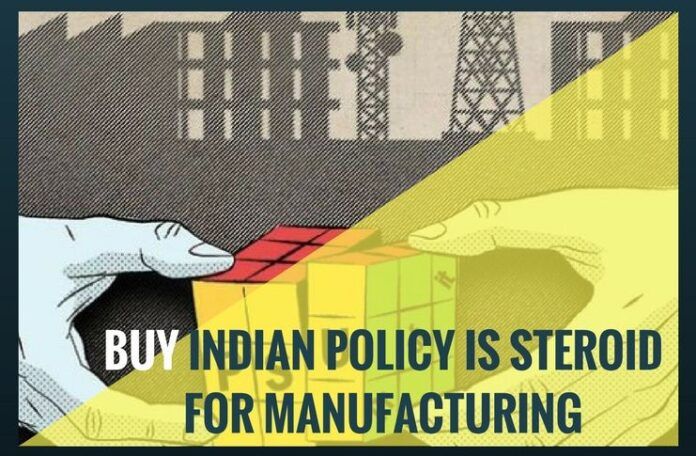
The revived “Buy Indian Policy”
[dropcap color=”#008040″ boxed=”yes” boxed_radius=”8px” class=”” id=””]T[/dropcap]he Government Procurement Preference to Make in India Order, 2017, is yet another instance of Prime Minister Narendra Modi’s penchant for embracing the policies of previous socialist regimes. The order is actually a rehash of the old programme called Be Indian, Buy Indian. The move is also indicative of the Prime Minister’s reluctance to effect meaningful economic reforms.
Local suppliers have been defined as those “whose goods or services meet prescribed minimum thresholds (ordinarily 50 per cent) for local content. Local content is essentially domestic value addition.”
This is not to say that it would spell disaster for the economy. There is also a slight possibility that in the short run the new policy boosts domestic manufacturing, which is languishing. But to expect that this would do wonders to the ambitious Make in India programme or galvanize the economy would be too optimistic.
The government’s expectations, however, border on sanguineness. An official statement said, “The new policy will give a substantial boost to domestic manufacturing and service provision, thereby creating employment. It will also stimulate the flow of capital and technology into domestic manufacturing and services. It will also provide a further thrust towards the manufacture of parts, components, sub-components etc. of these items, in line with the vision of ‘Make in India’.” In a nutshell, the government is peddling the new policy as a panacea.
But its provisions have the potential of it becoming an excuse for undue state meddling in the economy. Under the policy, says the official release, preference in government procurement will be given to local suppliers. Local suppliers have been defined as those “whose goods or services meet prescribed minimum thresholds (ordinarily 50 per cent) for local content. Local content is essentially domestic value addition.”
[dropcap color=”#008040″ boxed=”yes” boxed_radius=”8px” class=”” id=””]N[/dropcap]otice “ordinarily 50 per cent,” which means that discretion would be used to define any good or service as local. While procurement less than Rs 5 lakh has been kept out of the purview of the new rule, for goods worth Rs 5 lakh-Rs 50 lakh the nodal ministry would determine whether or not there are sufficient local capacity and local competition. If there is, only local suppliers will be eligible. This translates into more discretion.
Bureaucrats would decide whether local capacity/competition is sufficient and whether an order can be divided to more than one supplier.
For procurements valued at more than Rs 50 lakh (or where there is insufficient local capacity/competition), if the lowest bid is not from a non-local supplier, the lowest-cost local supplier who is within a margin of 20 per cent of the lowest bid, will be given the opportunity to match the lowest bid, says the official statement.
That is not all. “If the procurement is of a type that the order can be divided and given to more than one supplier, the non-local supplier who is the lowest bidder will get half of the order and the local supplier will get the other half if it agrees to match the price of the lowest bid. If the procurement cannot be divided, then the lowest cost local supplier will be given the order if it agrees to match the lowest bid.”
So, bureaucrats would decide whether local capacity/competition is sufficient and whether an order can be divided to more than one supplier. Besides, a Standing Committee in the Department of Industrial Policy & Promotion will oversee the implementation of this order and issues arising there from, and make recommendations to nodal ministries and procuring entities.
[dropcap color=”#008040″ boxed=”yes” boxed_radius=”8px” class=”” id=””]A[/dropcap]ll these procedures are not just a recipe for over-regulation of the economy, which flies in the face of Modi’s election slogan Maximum Governance, Minimum Government, but also is reminiscent of the discredited policies of import substitution and purchase preference for public sector undertakings.
It would be better for the Prime Minister to initiate real liberalization like labor reforms rather than revive old policies in a new garb. At best, the buy Indian move can be a steroid for manufacturing. But steroids cannot be allowed to be administered for longer periods, nor should the new policy should be.
Note:
1. The views expressed here are those of the author and do not necessarily represent or reflect the views of PGurus.
- Liberty Is Penalized, Violence Goes Untouched - December 21, 2019
- Rahul’s Howdy bloomer - September 22, 2019
- Chidambaram’s hypocrisy - August 22, 2019









Good article. But quite ambiguous since data presentation is not there.